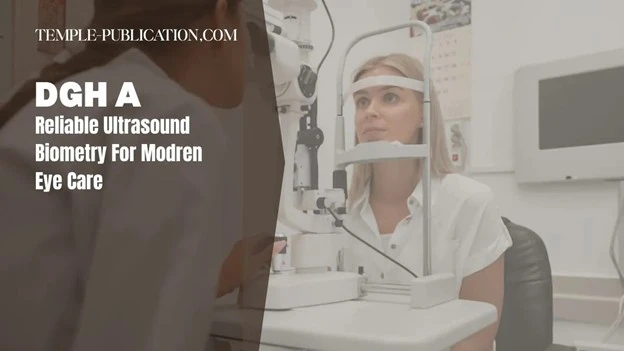HEALTH AND FITNESS
DGH A: Reliable Ultrasound Biometry for Modern Eye Care Practices

In such a rapidly changing environment as ophthalmology today, it is not an option to be inaccurate, but a necessity. Both when completing cataract surgeries and when assessing complicated post-refractive patients, accurate biometric information is the essential element of effective care. As needs escalate in portability, effortless application of EMR and novel diagnostics, clinics move towards smaller and software-driven instrumentation to generate hospital-quality results wherever operations are performed.
Enter the DGH A, also known as the DGH 6000 Scanmate A—a lightweight, USB-powered A-Scan biometer that’s transforming how modern eye care professionals measure and evaluate ocular structures.
What is the DGH A?
The DGH A (6000 Scanmate A) is a high-resolution ultrasound A-scan biometer designed explicitly for measuring key ocular parameters, including axial length, anterior chamber depth, and lens thickness. It utilises a 10 MHz transducer and supports both contact and immersion techniques, delivering remarkable precision with a repeatability of ±0.03 mm in immersion mode. Unlike older standalone units, the DGH A connects directly to a Windows PC, making it highly portable and accessible for in-office use.
The DGH A is utilized regularly by clinicians to perform biometric testing prior to the placement of intraocular lenses (IOL) surgery, where it is considered useful in validating the lens power calculations to be performed, even in the case of post-LASIK or even dense cataracts. Its user friendly software, smart alignment system, and real-time waveform analysis allows novice and master users to come up with consistenly good results.
Key Features of the DGH A
- High-Precision Imaging: The DGH A is equipped with a 10MHz transducer, providing reliable measurements with 0.03 mm repeatability in immersion mode, making it suitable for use in complex clinical settings.
- Compact & USB-Powered: The machine is directly connected to a Windows PC, eliminating the need for cumbersome equipment or a separate power source, which is ideal for mobile clinics or practices with limited space.
- Smart Alignment Feedback: Audible and visual feedback enable clinicians to keep the probe centred, decreasing the likelihood of error and enhancing measurement reliability.
- EMR/EHR Compatibility: Easy interactions with electronic health records facilitate the workflow, enhancing documentation and data accuracy in patient files.
How Does the DGH A Work?
The DGH A is a high-frequency ultrasound measurement of the distance between two surfaces of the ocular. As soon as the probe (transducer) is well placed, either through contact (lightly touching the cornea) or immersion (using a fluid-filled shell to prevent corneal compression), the machine records the echoes from the cornea, lens, and retina. These echoes are converted into a waveform mapped in the Scanmate software.
The software processes the peaks of the waveform using in-built algorithms and provides an averaging of consistent values, removing outliers. The user can choose from standard IOL power formulas, such as SRK/T, Hoffer Q, or Holladay, to obtain accurate IOL suggestions. The software provides real-time guidance to clinicians through its alignment system, which reduces variability and improves scan quality.
Applications in Clinical Practice
- Cataract Surgery: Accurately measures axial length to determine the ideal intraocular lens power.
- Post-Refractive Surgery: Offers consistent results even in eyes with altered corneal architecture due to LASIK or PRK.
- Routine Biometry: Essential for general ocular assessments, pre-operative evaluations, and refractive error monitoring.
- Pediatric Ophthalmology: Non-invasive and quick scanning is ideal for younger, less cooperative patients.
Software Integration & IOL Calculation
One of the most outstanding characteristics of the DGH A is the presence of Scanmate software, which acts as both the control centre and the data analysis unit of the device. After measurements have been detected, the software automatically analyses waveform patterns and identifies the best readings, displaying them in a user-friendly graphical dashboard layout.
Calculation of IOLs may be conducted in real-time using a wide variety of pre-installed formulas, and the system will permit clinicians to edit the constants in connection with the reasonableness for an individual patient or according to surgeon preferences. Moreover, through the integration of EMR and EHR, these results are directly accessible and can be added to the patient’s electronic medical record; thus, there is no need to manually retype documents and minimise mistakes in documentation.
User Experience & Portability
The portability of the DGH A should be considered as one of its greatest strengths. Lightweight, weighing less than 1 kg and equipped with a USB-powered source, the device is ideal for mobile eye camps, satellite clinics, or small ophthalmology offices.
Consumers appreciate the short setup duration, and the probe is also ergonomic and easy to clean between cycles. The software’s user interface (UI) is clean and menu-based. It requires no advanced technical knowledge to operate, making it accessible to both novice and experienced technicians, as well as residents in the ophthalmology field.
Challenges and Limitations
- PC Dependency: Since the DGH A requires a Windows computer, it cannot function independently like traditional console-based devices.
- Learning Curve with Immersion: Although immersion offers the highest accuracy, it demands more skill and training than the contact method.
- Limited Use in Dense Cataracts: In some cases with severe lens opacities, signal strength may be diminished, requiring additional scans or backup imaging tools.
- No Built-In Display: All interactions are software-driven, so if the PC malfunctions or isn’t available, the device can’t operate.
DGH A vs. Other A-Scan Biometers
| Feature | DGH A (6000 Scanmate) | Sonomed VuPad A-Scan | Tomey AL-4000 |
| Transducer Frequency | 10 MHz | 10 MHz | 10 MHz |
| Measurement Techniques | Contact & Immersion | Contact & Immersion | Contact Only |
| Accuracy (Repeatability) | ±0.03 mm (immersion) | ±0.04 mm | ±0.05 mm |
| EMR/EHR Integration | Yes | Yes | Limited |
| Portability | High (USB-Powered) | Medium (Tablet-Based) | Low (Console) |
| Software-Based IOL Calculations | Yes | Yes | Yes |
| Standalone Operation | No | Yes | Yes |
Comparisons with Similar Devices
- Sonomed VuPad offers a standalone tablet-like interface but costs significantly more.
- Tomey AL-4000 is accurate but lacks immersion support and modern software integration.
- The DGH A stands out for its balance of portability, precision, and cost-effectiveness, especially in clinics already using EMR systems.
Conclusion
The DGH A (6000 Scanmate A) is a perfect fit for current ocular practices seeking an affordable, lightweight, portable, and dependable ultrasound biometry system. It is highly accurate, can be used in both metric and imperial measurement systems, and can also be combined with electronic records. Although it requires a connected PC to work with and also comes with the compromise of needing to be skilled in immersion scanning, it offers numerous rewards that positively outweigh these few drawbacks.
To the cataract surgeon, to the general ophthalmologist, and the hand-held physician, the DGH A is a reliable companion in the round of exact eye surgery.
-

 BIOGRAPHY7 months ago
BIOGRAPHY7 months agoBehind the Scenes with Sandra Orlow: An Exclusive Interview
-

 HOME1 year ago
HOME1 year agoDiscovering Insights: A Deep Dive into the //vital-mag.net blog
-

 HOME1 year ago
HOME1 year agoSifangds in Action: Real-Life Applications and Success Stories
-

 BIOGRAPHY1 year ago
BIOGRAPHY1 year agoThe Woman Behind the Comedian: Meet Andrew Santino Wife




























